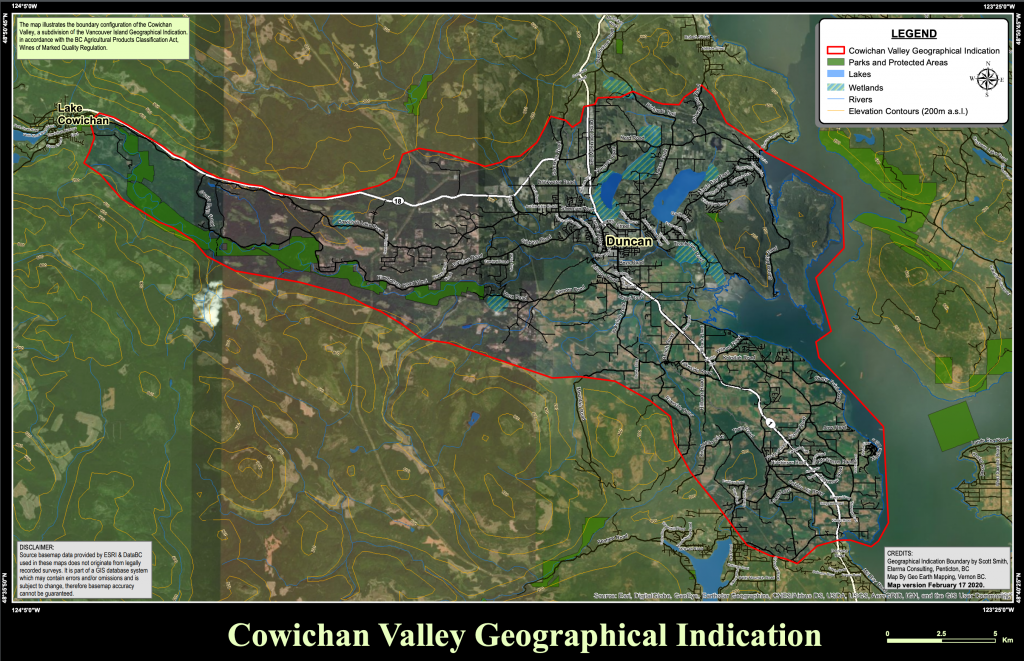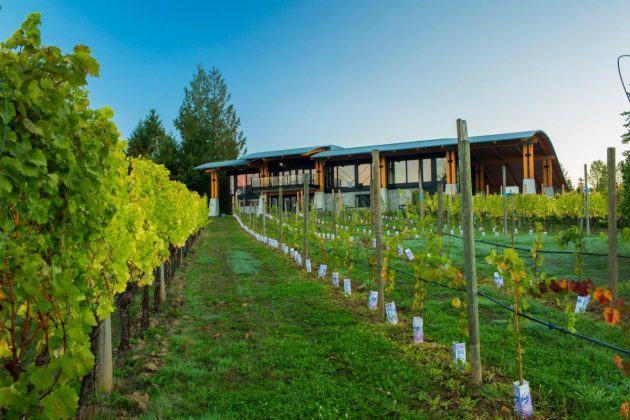
News
Fruit
New wine producing region recognized on Vancouver Island
The Cowichan Valley is being recognized as a new sub-geographical indication, an official term under B.C. law used to help consumers identify B.C. wines’ origins.
July 10, 2020 By Fruit and Vegetable
 A map of the Cowichan Valley, a new sub-geographical area to help consumers identify the origin of B.C. wines. Map courtesy of Geo Earth Mapping.
A map of the Cowichan Valley, a new sub-geographical area to help consumers identify the origin of B.C. wines. Map courtesy of Geo Earth Mapping. British Columbians shopping for a bottle of B.C. wine will see a new area recognized for their grape-growing and winemaking on the label: the Cowichan Valley.
The Cowichan Valley is being recognized as a new sub-geographical indication (sub-GI), an official and protected term under B.C. law used to help consumers identify B.C. wines’ origins. The Cowichan Valley sub-GI is roughly defined as the area between the Cowichan watershed, the eastern coastline from Mill Bay to Maple Bay and the western area of Cowichan Lake.
“The newly announced Cowichan Valley sub-GI recognizes our unique terroir and solidifies Vancouver Island’s position as an up-and-coming wine destination. Bailey Williamson, Blue Grouse’s winemaker, led the initiative, but it would not have been possible without the enthusiastic co-operation of every winery and grape grower in the valley. We are proud to be part of such a cohesive group of wine lovers and look forward to being part of an exciting future,” said Paul Brunner, owner of Blue Grouse Estate Winery in the Cowichan Valley.
“The newly announced Cowichan Valley sub-GI recognizes our unique terroir and solidifies Vancouver Island’s position as an up-and-coming wine destination. Bailey Williamson, Blue Grouse’s winemaker, led the initiative, but it would not have been possible without the enthusiastic co-operation of every winery and grape grower in the valley.”
British Columbia is home to 929 vineyards, with over 60 different grape varieties grown in the province. Popular varieties grown in the Cowichan Valley include Ortega, Bacchus, Gewürztraminer, Pinot Gris, Marechal Foch and Pinot Noir.
Wines must be “BC VQA” certified in order to display the geographic and sub-geographic indications in the province. The British Columbia Wine Authority who oversees the BC Vintners Quality Alliance (BC VQA) program, certifies wines produced across B.C. ensuring that they are of a certain quality, meet the labelling regulations and use the correct geographical indicators for wines made from grapes in the different regions of the province.

Bailey Williamson, Blue Grouse’s (pictured) winemaker, led the initiative, but owner of Blue Grouse Estate Winery says it would not have been possible without the enthusiastic co-operation of every winery and grape grower in the valley. Photo courtesy of Blue Grouse Estate Winery.
Defining geographic zones on wine labels connects consumers with the unique geographic area the grapes are grown and the wine is made in and increases exposure to the region for both wine and tourism businesses.
“Officially recognizing the Cowichan Valley as a distinct and unique wine grape-growing region in B.C. is a testament to the hard work, passion and dedication of the many local entrepreneurs and staff in the wine industry,” said Sonia Furstenau, MLA for Cowichan Valley. “This is a well-deserved accomplishment for all those involved in producing exceptional wines and memorable winery experiences.”
“The Cowichan is home to family-owned and operated wineries and grape growers who have been part of the valley for generations,” said Lana Popham, provincial minister of agriculture, in a released statement. “They take pride in the wines they produce and recognizing their hard work, skills and growing reputation on the B.C. and international stage is overdue. They make great wine in the Cowichan from the grapes grown in the valley, and the designation both respects and promotes that.”
Wines labelled with geographical indications and/or sub-GIs commit to consumers that the wine was produced with a minimum of 95 per cent of grapes grown from the specified region.
Wines labelled with geographical indications and/or sub-GIs commit to consumers that the wine was produced with a minimum of 95 per cent of grapes grown from the specified region.
There are nine official geographical indications in the province and five sub-geographical indications. The Cowichan Valley is the first sub-GI outside of the Okanagan and joins the Golden Mile Bench, Naramata Bench, Okanagan Falls and Skaha Bench in the Okanagan Valley. The nine geographical indications include Fraser Valley, Gulf Islands, Kootenays, Lillooet, Okanagan Valley, Shuswap, Similkameen Valley, Thompson Valley and Vancouver Island.
Print this page